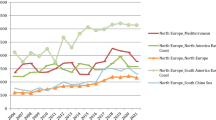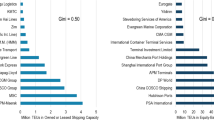Abstract
As a consequence of the delivery of large container ships and of the drop in demand since 2008, companies are struggling with low freight rates. In addition, newly delivered container ships have been deployed on the main east–west trades, whereas medium-sized vessels have been pushed to smaller sectors through a phenomenon known as the cascading effect. This article investigates how this effect might lead liner companies to modify their services, such as including additional stops at major hubs. This article proposes a model that factors in potential changes in network configuration from direct to indirect services, and then tests the model with an empirical study of northern Europe/South American services that adds in a call at Tangier or Algeciras to the schedule. The results show that the optimal network configuration depends on vessel sizes and the transshipment volumes to be collected at the hub.


Similar content being viewed by others
References
Agarwal, R. and Ergun, Ö. (2008) Ship scheduling and network design for cargo routing in liner shipping. Transportation Science 42 (2): 175–196.
Alphaliner. (2011) Evolution of time charter rate, http://www.alphaliner.com/liner2/research_files/liner_studies/nograph/CharterRates.pdf, accessed 20 October 2012.
Bandeira, D.L., Becker, J.L. and Borenstein, D. (2009) A DSS for integrated distribution of empty and full containers. Decision Support Systems 47 (4): 383–397.
Buhaug, O. et al (2009) Second IMO Greenhouse Gas Study. London: International Maritime Organization.
Cariou, P. (2011) Is slow steaming a sustainable means of reducing CO2 emissions from container shipping? Transportation Research Part D 16 (3): 260–264.
Chang, Y.-T., Lee, S.-Y. and Tongzon, J.L. (2008) Port selection factors by shipping lines: Different perspectives between trunk liners and feeder service providers. Marine Policy 32 (6): 877–885.
Christiansen, M., Fagerholt, K. and Ronen, D. (2004) Ship routing and scheduling: Status and perspectives. Transportation Science 38 (1): 1–18.
Clarkson Research Database. (2013) http://www.crsl.com, accessed 20 December 2013.
CMA CGM. (2011) http://www.cma-cgm.com/static/eCommerce/Attachments/GuideConservation.pdf, accessed 20 October 2012.
CMA CGM rates. (2011) http://www.cma-cgm.com/, accessed 20 October 2012.
Corbett, J.J., Wang, H. and Winebrake, J.J. (2009) The effectiveness and costs of speed reductions on emissions from international shipping. Transportation Research Part D 14 (8): 593–598.
CS Shipping Containers (CSSC). (2011) http://www.csshippingcontainers.co.uk/, accessed 20 October 2012.
Drewry Maritime Research. (2011) Container Forecaster 3Q11. London: Drewry Maritime Research.
Fagerholt, K. (2004) Designing optimal routes in a liner shipping problem. Maritime Policy & Management 31 (4): 259–268.
Fitzgerald, W.B., Howitt, O.J.A., Smith, I.J. and Hume, A. (2011) Energy use of integral refrigerated containers in maritime transportation. Energy Policy 39 (4): 1885–1896.
Foxcroft, A. (2010) Market Analysis: Container Leasing Market. London: Informal Communications.
Fremont, A. (2007) Global maritime networks: The case of Maersk. Journal of Transport Geography 15 (6): 431–442.
Gelareh, S., Nickel, S. and Pisinger, D. (2010) Liner shipping hub network design in a competitive environment. Transportation Research Part E 46 (6): 991–1004.
Gelareh, S. and Pisinger, D. (2011) Fleet deployment, network design and hub location of liner shipping companies. Transportation Research Part E 47 (6): 947–964.
Hsu, C.I. and Hsieh, Y.P. (2007) Routing, ship size, and sailing frequency decision-making for a maritime hub-and-spoke container network. Mathematical and Computer Modelling 45 (7–8): 899–916.
Jetlund, A.S. and Karimi, I.A. (2004) Improving the logistics of multi-compartment chemical tankers. Computers and Chemical Engineering 28 (8): 1267–1283.
Lirn, T.C., Thanopoulou, H.A., Beynon, M.J. and Beresford, A.K.C. (2004) An application of AHP on transhipment port selection: A global perspective. Maritime Economics & Logistics 6 (1): 70–91.
Lloyd’s Register Fairplay. (2010) World shipping encyclopedia, http://www.ihs.com/products/maritime-information/index.aspx?pu=1/&rd=ihsfairplay_com/#, accessed 20 October 2012.
McCalla, R.J. (2008) Container transshipment at Kingston, Jamaica. Journal of Transport Geography 16 (3): 182–190.
Notteboom, T.E. (2012) Container shipping. In: W. Talley (ed.) The Blackwell Companion to Maritime Economics. Oxford: Wiley-Blackwell.
Notteboom, T.E. and Vernimmen, B. (eds.) (2008) The impact of fuel costs on liner service design in container shipping. Proceedings of the Conference of the International Association of Maritime Economists; 2–4 April 2008, Dalian, China.
Notteboom, T.E. and Vernimmen, B. (2009) The effect of high fuel costs on liner service configuration in container shipping. Journal of Transport Geography 17 (5): 325–337.
Ramos, D. (2010) Linking efficient reefer logistics with higher environmental demands. Paper presented at the Eurofruit Congress Southern Hemisphere; 1–3 December, Punta del Este, Uruguay.
Ronen, D. (2011) The effect of oil price on containership speed and fleet size. Journal of the Operational Research Society 62 (1): 211–216.
Sea Distance (Voyage Calculator). (2011) http://sea-distances.com/, accessed 20 October 2012.
Shintani, K., Imai, A., Nishimura, E. and Papadimitriou, S. (2007) The container shipping network design problem with empty container repositioning. Transportation Research Part E 43 (1): 39–59.
Tang, S.L. and Yan, H. (2010) Pre-distribution versus post-distribution for cross-docking with transshipments. Omega 38 (3–4): 192–202.
Vis, I. and de Koster, R. (2003) Transshipment of containers at a container terminal: An overview. European Journal of Operational Research 147 (1): 1–16.
Wang, S. and Meng, Q. (2012) Liner ship fleet deployment with container transshipment operations. Transportation Research Part E 48 (2): 470–484.
Acknowledgements
The authors wish to acknowledge the anonymous referees and the Editor-in-Chief for their valuable comments.
Author information
Authors and Affiliations
Appendix
Appendix
Rights and permissions
About this article
Cite this article
Cariou, P., Cheaitou, A. Cascading effects, network configurations and optimal transshipment volumes in liner shipping. Marit Econ Logist 16, 321–342 (2014). https://doi.org/10.1057/mel.2014.4
Published:
Issue Date:
DOI: https://doi.org/10.1057/mel.2014.4




